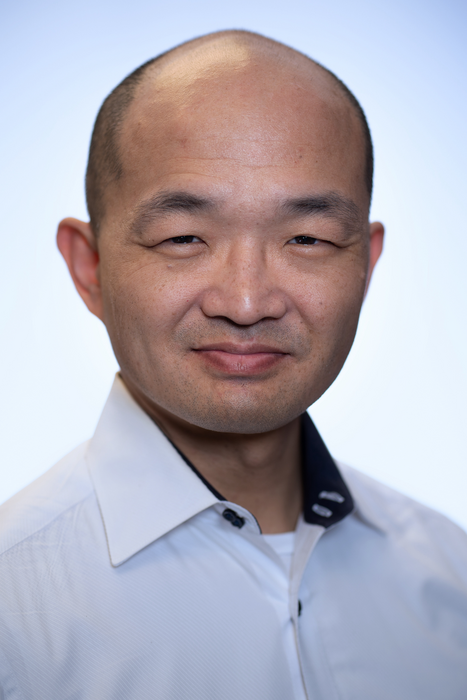Researchers at the University of Toronto and New York University have developed a novel technology that can engineer proteins to target any stretch of DNA in the human genome, opening a door toward gene therapies for a broader range of health conditions.

Credit: University of Toronto
Researchers at the University of Toronto and New York University have developed a novel technology that can engineer proteins to target any stretch of DNA in the human genome, opening a door toward gene therapies for a broader range of health conditions.
The researchers fed data from billions of interactions between zinc finger proteins and DNA into a machine-learning model, which can then generate engineered zinc fingers that bind to any given sequence of DNA.
“Designing zinc fingers to bind specific DNA targets has been an unsolved problem for decades,” said Philip M. Kim, a professor in the Donnelly Centre for Cellular and Biomolecular Research at U of T’s Temerty Faculty of Medicine. “Our work should enable a new generation of in vivo therapeutics, which have proven difficult to develop with CRISPR and other DNA targeting technologies.”
The journal Nature Biotechnology published the findings today.
Zinc fingers are a common class of human proteins that regulate gene expression, a process that transcribes genetic information into RNA molecules and proteins. Scientists have long seen their potential because they naturally bind with DNA, are less likely than CRISPR and related technologies to trigger an immune reaction, and are small enough to work with clinical delivery methods.
But zinc fingers were hard to engineer — for every new DNA target, scientists had to engineer a new protein through a laborious and often unsuccessful workflow. The new system solves this problem with a universal model that offers ease of use comparable to CRISPR, and potentially higher DNA specificity.
“I think this system levels the playing field for zinc fingers and CRISPR,” said Kim, who is also a professor of molecular genetics and computer science at U of T. “CRISPR is very established for fundamental science, but our system has many advantages for applications in living systems, in particular that zinc fingers are human proteins and would be safer as injected drugs.”
The system can also generate many different proteins that do the same thing, offering more options for moving treatments toward the clinic.
Kim and his lab developed the zinc finger model with a research group at NYU Langone Health led by Marcus Noyes, an assistant professor of biochemistry and molecular pharmacology in the Institute for Systems Genetics at the Grossman School of Medicine.
The Noyes lab has studied zinc fingers for years, and they compiled data on 49 billion interactions among zinc finger proteins and DNA by creating high-throughput screens of several zinc finger libraries. Their approach combined two levels of data: interactions between single zinc fingers and DNA, and between each zinc finger and its neighbouring finger.
These zinc finger pair interactions influence DNA binding and hence gene expression.
The machine-learning model developed by Kim and his group mirrors the data synthesis approach in the Noyes lab. “Our model is hierarchical, so it takes advantage of existing data from their first stage of screening — and a subset of their stage-two data — to develop predictions about which zinc fingers will be compatible with others in certain contexts,” said Osama Abdin, a doctoral student in Kim’s lab and co-first author on the paper.
The model is based in part on technology that also forms the basis of ChatGPT, a software application developed by OpenAI that simulates human conversation. The model generates amino acid sequences for zinc finger proteins using large, highly detailed data sets and techniques similar to natural language processing.
The researchers showed the utility of the zinc finger system, which they dubbed ZFDesign, by reprogramming human transcription factors — zinc finger proteins that regulate the transcription of DNA to RNA. They tweaked the DNA binding targets of several transcription factors and programmed them to either activate or repress multiple genes, working with Professors Tim Hughes and Mikko Taipale in the Donnelly Centre.
Clinical application of reprogrammed transcription factors could target diseases caused by haploinsufficiency — deletion or inactivation of a copied gene, as in some cancers and the connective tissue disorders known as Ehlers-Danlos syndrome — or those linked to toxic genetic repeats, as in neurodegenerative conditions such as ALS, Parkinson’s and Huntington’s disease.
Kim said the system already generates designs for zinc finger proteins with clinical potential, and that both his team in Toronto and the group in New York were surprised by how well it worked. The researchers have started a company, TBG Therapeutics, that aims to develop new therapies using this technology.
The new system also holds promise for gene editing and other applications where CRISPR is useful, although its impact will likely be strongest in the area of reprogramming transcription factors, Kim said.
The next step is to improve specificity in the system. “The current model is designed to optimize the engagement of a given zinc finger protein with its target, but has no built-in awareness of interactions to other targets,” said Kim. “Optimizing for specificity will entail modeling these other interactions.”
The researchers are well on their way to building a model that offers more specificity, Kim said. “There is a lot of excitement around this work in the fields of epigenetics and gene therapy, and I look forward to seeing what we can achieve with this technology.”
Journal
Nature Biotechnology
DOI
10.1038/s41587-022-01624-4
Method of Research
Experimental study
Subject of Research
Cells
Article Title
A universal deep-learning model for zinc finger design enables transcription factor reprogramming
Article Publication Date
26-Jan-2023
COI Statement
MT, PMK, and MBN are founders of TBG Therapeutics. Intellectual property has been filed on the method for generating the ZFs, the design model, and the method to reprogram TFs.




